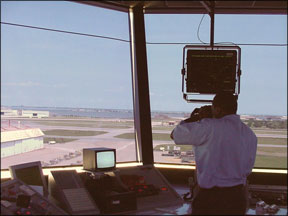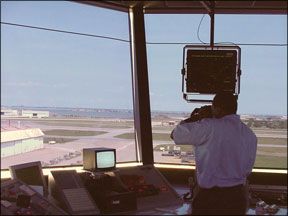After an IFR flight of nearly four hours, my wife and I approached a north central U.S. airport in our Mooney. We had descended below the 6000-foot overcast to find excellent visibility. My wife handled the communications while I flew; her first call to the tower, from more than 10 miles out, was met with the question, “Are you IFR or VFR?” She responded that we had canceled our IFR flight plan and were VFR with the field in sight. We were advised to enter a left downwind for the east-west runway. 288 The tower was busy with three inbounds from the southeast and at least two singles and a twin in the pattern, plus our Mooney inbound from the east. Closer in, we were advised to enter the left downwind for the northeast/southwest runway. The change was not unexpected since traffic was using that runway. The tower sequenced us to follow the second single on left base. With no sun, it was easy for us to see the two singles in the left-hand pattern and the twin on right downwind. We turned base leg with our traffic preparing to turn base-to-final and the first single on short final. The twin was still on the right downwind. As we prepared to turn final we saw that the twin had turned right base at approximately the same distance from the field but slightly higher. I inquired about the twin. The tower responded, asking the twin if it had the Mooney in sight and instructing us to continue our approach. The twin reported it had the Mooney in sight. The tower instructed the twin to follow the Mooney. The twin acknowledged. As we turned final the twin was still on right base and much too close to sequence behind us. My wife and I were frantically looking for the twin behind us. Suddenly the windscreen was nearly filled with the underside of the twin passing 30 to 50 feet above us. At this point the tower realized the conflict and instructed us to offset to the right and go around. We had witnessed our first near-miss and we were part of it! The tower then instructed the twin to go around, but cleared it to land as we responded that the Mooney was going around. It was only luck that the twin passed above our Mooney. An instructor and student were executing a simulated engine-out procedure and, by the instructors account, were maintaining a higher than normal approach path. In their training environment, the instructor and the student in the twin were preoccupied with their workload and not aware of their sequence. The instructor confessed that he had mistaken the PA-28 on short final for our Mooney. In the future, this Mooney driver will be more likely to act on his own visual assessment of pattern traffic rather than allowing himself to be reassured by ATC or acknowledgements from other aircraft, neither of whom had the better view of the situation in this instance.




